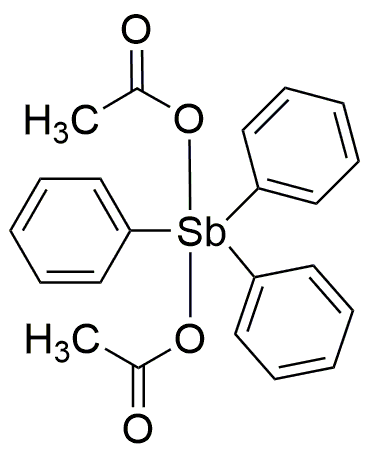Triphenylantimony diacetate is widely utilized in research focused on:
- Organometallic Chemistry: It serves as a precursor for synthesizing various organometallic compounds, enabling researchers to explore new materials with unique properties.
- Catalysis: This compound is used as a catalyst in organic reactions, enhancing reaction rates and improving yields, particularly in the synthesis of complex organic molecules.
- Pharmaceutical Development: It plays a role in drug formulation and development, particularly in creating compounds with antitumor activity, making it valuable in the pharmaceutical industry.
- Material Science: Employed in the production of advanced materials, it contributes to the development of high-performance polymers and composites, which are essential in various engineering applications.
- Environmental Chemistry: It is used in studies related to environmental monitoring and remediation, helping researchers understand the behavior of antimony compounds in ecological systems.
General Information
Properties
Safety and Regulations
Applications
Triphenylantimony diacetate is widely utilized in research focused on:
- Organometallic Chemistry: It serves as a precursor for synthesizing various organometallic compounds, enabling researchers to explore new materials with unique properties.
- Catalysis: This compound is used as a catalyst in organic reactions, enhancing reaction rates and improving yields, particularly in the synthesis of complex organic molecules.
- Pharmaceutical Development: It plays a role in drug formulation and development, particularly in creating compounds with antitumor activity, making it valuable in the pharmaceutical industry.
- Material Science: Employed in the production of advanced materials, it contributes to the development of high-performance polymers and composites, which are essential in various engineering applications.
- Environmental Chemistry: It is used in studies related to environmental monitoring and remediation, helping researchers understand the behavior of antimony compounds in ecological systems.
Documents
Safety Data Sheets (SDS)
The SDS provides comprehensive safety information on handling, storage, and disposal of the product.
Product Specification (PS)
The PS provides a comprehensive breakdown of the product’s properties, including chemical composition, physical state, purity, and storage requirements. It also details acceptable quality ranges and the product's intended applications.
Certificates of Analysis (COA)
Search for Certificates of Analysis (COA) by entering the products Lot Number. Lot and Batch Numbers can be found on a product’s label following the words ‘Lot’ or ‘Batch’.
*Catalog Number
*Lot Number
Certificates Of Origin (COO)
This COO confirms the country where the product was manufactured, and also details the materials and components used in it and whether it is derived from natural, synthetic, or other specific sources. This certificate may be required for customs, trade, and regulatory compliance.
*Catalog Number
*Lot Number
Safety Data Sheets (SDS)
The SDS provides comprehensive safety information on handling, storage, and disposal of the product.
DownloadProduct Specification (PS)
The PS provides a comprehensive breakdown of the product’s properties, including chemical composition, physical state, purity, and storage requirements. It also details acceptable quality ranges and the product's intended applications.
DownloadCertificates of Analysis (COA)
Search for Certificates of Analysis (COA) by entering the products Lot Number. Lot and Batch Numbers can be found on a product’s label following the words ‘Lot’ or ‘Batch’.
*Catalog Number
*Lot Number
Certificates Of Origin (COO)
This COO confirms the country where the product was manufactured, and also details the materials and components used in it and whether it is derived from natural, synthetic, or other specific sources. This certificate may be required for customs, trade, and regulatory compliance.


